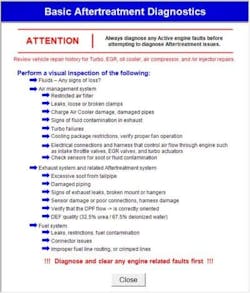Tech Tip: Using a checklist to save time, money, and parts
As vehicle complexity rises, the industry experiences positive side effects, as well as some challenges. Many of those challenges occur within the diagnosis process. For example, an increased number of electronic vehicle components means many different systems within the vehicle can produce the same symptom. It is essential to determine the root cause of that symptom, rather than applying a temporary solution that will soon manifest again and lead to unnecessary downtime. Not accurately detecting the root cause when a vehicle is initially in the shop leads to lost labor hours and, potentially, wasted parts.
Nearly every technician can recall a time he or she spent hours diagnosing a problem that only took minutes to fix after the root cause was determined. This diagnosis time is critical to technicians, service centers, and fleets. Speeding this time allows technicians to earn more due to working on more vehicles, improves a shop’s profits by increasing efficiency, and produces cost savings for a fleet through reduced downtime. Luckily, a simple checklist is all that is needed to improve the process.
Creating a checklist
Industry professionals recognize JPRO Professional for its advanced diagnosis and repair capabilities, but the software also reminds users it is often best to start with the basics. When users launch the Aftertreatment Diagnostics screen, they are welcomed with a pop up of a checklist. The purpose of the checklist is to provide the user with common root causes to decrease the time required to detect what is causing the symptom. The comprehensive list includes visual checks the technician should perform, as well as functions within JPRO, such as checking battery voltage.
Although the provided checklist is quite extensive, it serves as a strong starting point for technicians. Best practices in the shop dictate that a technician should apply their own knowledge and experiences and potentially modify the existing checklist to maximize their efficiency in the bay. By routinely checking off common problems the technician experiences in their day-to-day repairs, the basics simply become second nature and improve the overall long-term accuracy and speed of their diagnoses.
Misdiagnosis – A costly mistake
There are many external influences on aftertreatment systems and a reliable checklist ensures technicians first look for obvious causes. For example, imagine a vehicle arrives and the driver explains the truck derated to a point that a breakdown was a concern. The technician listens to the complaint, connects diagnostic software to the vehicle, and discovers an active code for a high soot level. At this point, many technicians will immediately perform a forced regen, which will often clear the active fault code by reducing the soot level. Unfortunately, this was only a temporary solution, later causing additional downtime for the vehicle. Why? The technician did not correctly determine the root cause.
The actual root cause was a leaking exhaust manifold gasket, which was allowing the critical heat necessary for passive regenerations to escape, which resulted in incomplete regenerations and led to the derate that brought the customer to the shop. By performing a forced regeneration, the technician was able to raise the temperature of the exhaust due to the added diesel fuel injected into the exhaust stream. The regen lowered particulate matter in the DPF, resulting in the code clearing from the truck.
However, after 250 miles, the same issue occurs and the driver has to return to a shop to avoid a costly breakdown. Had the technician started with the checklist, he would have detected the exhaust leak and performed a lasting repair. By not using a checklist, the technician caused the fleet to incur unnecessary costs and downtime, potentially threatening an on-time delivery.
A checklist of common root causes will never eliminate anomaly trucks that prove difficult to diagnose, but it will speed the process for many day-to-day repairs. Coupled with the skills and knowledge to perform advanced diagnostics when needed, a technician armed with a well-defined routine is certain to improve a shop’s, and their customer’s, operations.
Information provided by Noregon Systems, Inc.
